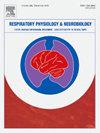Ventilation differences in the menstrual cycle: A systematic review and meta-analysis
IF 1.6
4区 医学
Q3 PHYSIOLOGY
引用次数: 0
Abstract
Background
Minute ventilation (V̇E) may vary across the menstrual cycle due to cyclical changes in sex hormones, potentially exerting an exercise intensity dependent effect.
Objective
This systematic review and meta-analysis aimed to quantify differences in V̇E, respiratory frequency (RF), and tidal volume (VT) between the follicular and luteal phases at rest, during submaximal exercise (≤90 %V̇O2max), and at incremental maximum (100 %V̇O2max).
Methods
The systematic review adhered to PRISMA guidelines for conducting and reporting systematic reviews. Studies included healthy eumenorrheic females (≥18 years) not using hormonal contraceptives. Studies that reported V̇E in the follicular and luteal phases were included. RF and VT were extracted as secondary outcome measures. Searches were conducted in Cochrane, PubMed, and EBSCO databases in January 2025. Study quality was assessed using the modified Downs and Black checklist for menstrual cycle research. Data were extracted and analysed using maximum likelihood random-effect meta-analyses followed with meta-regressions with intensity and duration as a moderator in submaximal exercise. Publication bias was assessed using Egger’s test. Meta-regressions were also conducted for resting and submaximal datasets using change in progesterone as a moderator.
Results
A total of 35 studies inclusive of 743 participants and 64 paired datasets were included. V̇E was lower in the follicular phase than the luteal phase at rest (ES = −0.64, p < 0.001, I2 = 75.74 %) and during submaximal exercise (ES = −0.89, p < 0.001, I2 = 76.58 %), with no effect of study quality. Meta-regression revealed that duration and intensity did not influence menstrual cycle effect on V̇E in submaximal exercise. At incremental maximum, a small but significant effect was observed towards higher V̇E in the luteal phase than the follicular phase (ES = −0.33, p = 0.03, I2 = 61.5 %) however this effect was no longer observed after removal of low-quality studies. All analyses were coupled with significant heterogeneity. Meta-regression demonstrated that change in progesterone significantly predicted V̇E changes during submaximal exercise (p = 0.02), but not at rest (p = 0.07). RF and VT analyses suggested minimal menstrual cycle effect, with only VT reductions at rest contributing to V̇E differences, this was likely related to the low number of studies included.
Conclusions
The menstrual cycle significantly influences V̇E, with lower values in the follicular phase at rest and during submaximal exercise. Changes in progesterone partially explain the differences in V̇E between menstrual phases during exercise but not at rest. At maximal intensities, hormonal influence on V̇E is minimal which corroborates the hypothesis that physiological mechanisms override hormonal mediation of ventilatory responses at high intensities. These findings suggest potential implications for exercise performance, particularly endurance activities in the luteal phase due to the increased likelihood of hyperventilation.
月经周期的通气差异:一项系统回顾和荟萃分析
背景:由于性激素的周期性变化,每分钟通气量(V (E))可能在月经周期中发生变化,可能产生运动强度依赖效应。目的:本系统综述和荟萃分析旨在量化静息、次极大运动(≤90 %V * O2max)和最大增量运动(100 %V * O2max)时卵泡期和黄体期的V * E、呼吸频率(RF)和潮气量(VT)的差异。方法系统评价遵循PRISMA指南进行和报告系统评价。研究对象为未使用激素避孕药的健康痛经女性(≥18岁)。研究报告了卵泡期和黄体期的V (E)。提取RF和VT作为次要结局指标。检索于2025年1月在Cochrane、PubMed和EBSCO数据库中进行。研究质量采用经修改的Downs和Black月经周期研究检查表进行评估。数据提取和分析采用最大似然随机效应荟萃分析,随后进行荟萃回归,以强度和持续时间作为次最大运动的调节因素。采用Egger’s检验评估发表偏倚。使用孕酮变化作为调节因子,还对静息和次极大数据集进行了meta回归。结果共纳入35项研究,743名受试者,64组配对数据集。静息时卵泡期的V (E)比黄体期低(ES = - 0.64, p <; 0.001,I2 = 75.74 %)和次最大运动时的V (E) (ES = - 0.89, p <; 0.001,I2 = 76.58 %),对研究质量没有影响。meta回归分析显示,持续时间和强度不影响月经周期对亚极限运动时V (E)的影响。在最大增量时,观察到黄体期比卵泡期有较小但显著的影响(ES = - 0.33, p = 0.03,I2 = 61.5 %),但在剔除低质量研究后,不再观察到这种影响。所有分析均伴有显著异质性。meta回归显示,孕酮水平的变化显著预测了亚极限运动时的V (E)变化(p = 0.02),而在静止状态下则不显著(p = 0.07)。RF和VT分析表明,月经周期的影响最小,只有静止时VT降低才会导致V (E)差异,这可能与纳入的研究数量较少有关。结论月经周期明显影响V (E),在卵泡期休息和次极大运动时V (E)较低。黄体酮的变化部分解释了运动时而不是休息时不同月经期的V (E)差异。在最大强度下,激素对肺活量的影响最小,这证实了生理机制在高强度下优于激素介导的通气反应的假设。这些发现提示了运动表现的潜在影响,特别是黄体期耐力活动,因为过度通气的可能性增加。
本文章由计算机程序翻译,如有差异,请以英文原文为准。
求助全文
约1分钟内获得全文
求助全文
来源期刊
CiteScore
4.80
自引率
8.70%
发文量
104
审稿时长
54 days
期刊介绍:
Respiratory Physiology & Neurobiology (RESPNB) publishes original articles and invited reviews concerning physiology and pathophysiology of respiration in its broadest sense.
Although a special focus is on topics in neurobiology, high quality papers in respiratory molecular and cellular biology are also welcome, as are high-quality papers in traditional areas, such as:
-Mechanics of breathing-
Gas exchange and acid-base balance-
Respiration at rest and exercise-
Respiration in unusual conditions, like high or low pressure or changes of temperature, low ambient oxygen-
Embryonic and adult respiration-
Comparative respiratory physiology.
Papers on clinical aspects, original methods, as well as theoretical papers are also considered as long as they foster the understanding of respiratory physiology and pathophysiology.

 求助内容:
求助内容: 应助结果提醒方式:
应助结果提醒方式:


